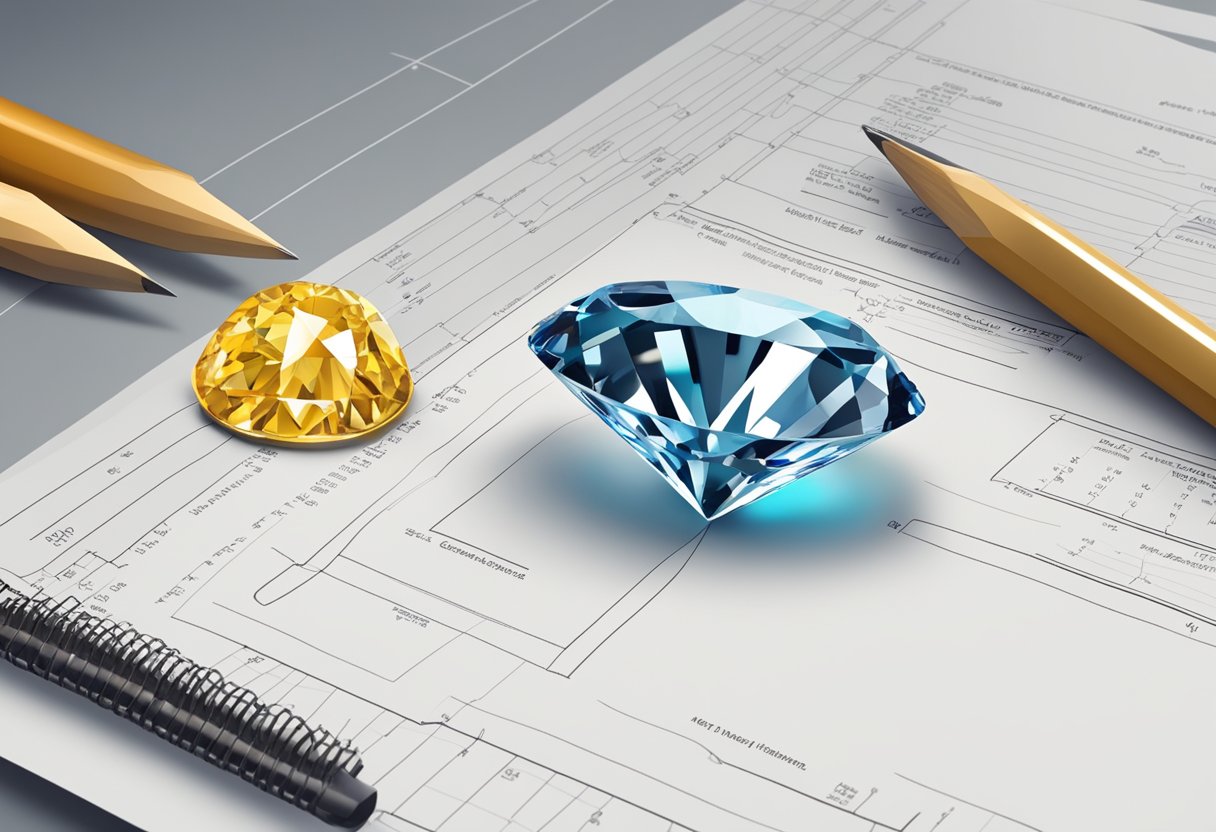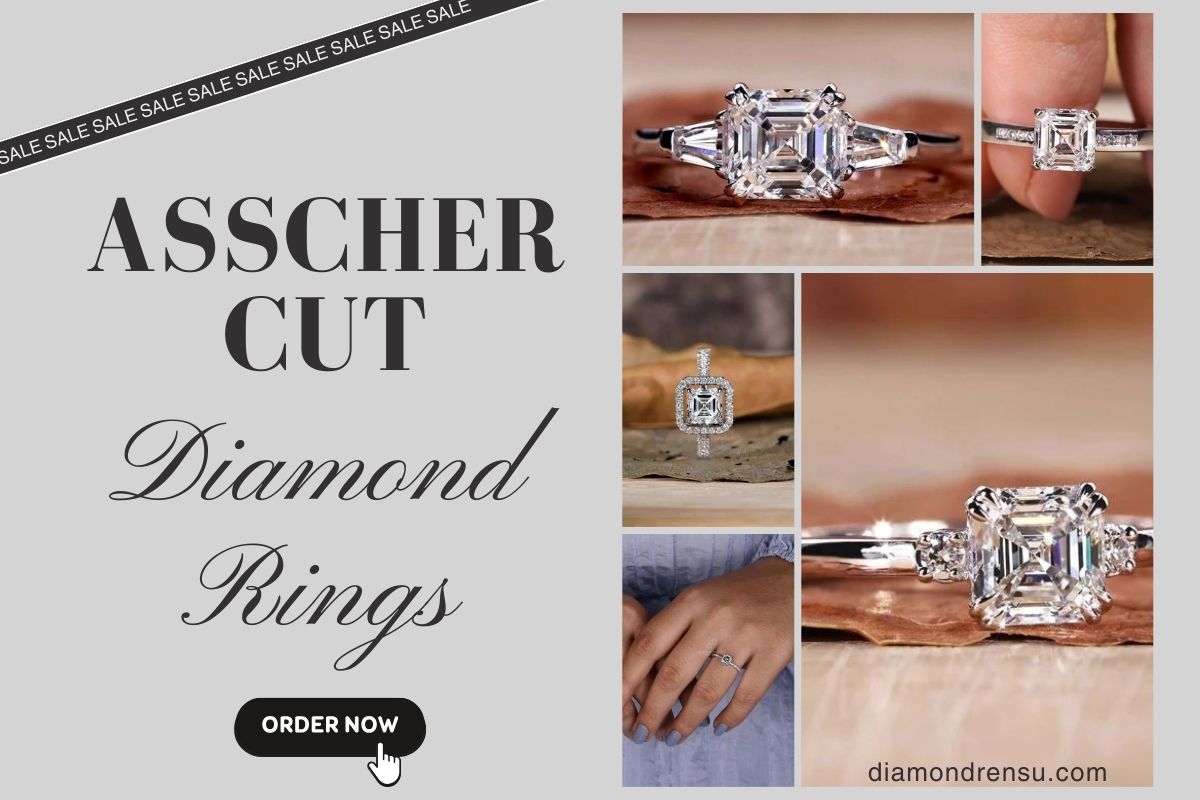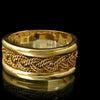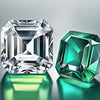
Are Asscher Cut Diamonds More Expensive: Unveiling the Cost Factors
When exploring the landscape of diamond cuts, we encounter a variety of shapes, each with its unique appeal and price point. Among these, Asscher cut diamonds stand out for their distinctiveness and the method by which they are crafted. The Asscher cut is a step cut, similar to the emerald cut, characterized by its square shape with deeply trimmed corners, which gives it an almost octagonal appearance. Its unique structure demands that only high-quality rough diamonds are selected, as the cut's wide step facets and large open table do not easily conceal inclusions or blemishes.
In terms of cost, Asscher cut diamonds often present a more complex narrative than simply being labeled as expensive or affordable. While the cut retains more of the raw stone than more intricate shapes, which can theoretically influence the price positively, it's the overall demand and cutting process that largely dictate the cost. High clarity is paramount for an Asscher cut diamond, due to its transparent nature, and such quality in the raw material can affect the final price. As a result, Asscher cuts can be less expensive than round brilliants, which waste more raw material during cutting but can still command a higher price compared to other fancy shapes due to the high caliber of the rough diamonds required.
Our understanding of diamond pricing must take into account factors like cut precision, raw material quality, and market demand. With the Asscher cut, we see a meticulous balance between preserving the raw stone's weight and ensuring the cut's clear, captivating allure. This equilibrium plays a significant role in determining the value of Asscher cut diamonds, making them a noteworthy option for those seeking elegance and clarity in their jewelry.
The Asscher Cut Diamond
In our exploration of diamond cuts, the Asscher cut stands out for its sophistication and vintage appeal. Our discussion will traverse the historical significance of this cut, its defining features, and the exclusivity of the Royal Asscher Cut.
History and Origin
The Asscher cut diamond was pioneered in 1902 by Joseph Asscher of the Royal Asscher Diamond Company, then simply known as the Asscher Brothers. Its creation was well-timed with the onset of the Art Deco period, an era when it gained immense popularity for its clean lines and geometric symmetry.
Characteristics of the Asscher Cut
Shape
🔷 Square shape with cropped corners
Facets
💎 Features large step-cut facets
Clarity
🔍 High clarity is essential due to large facets
Brilliance
✨ Creates a hall-of-mirrors effect
Origin
🕰️ Developed in 1902 by Joseph Asscher
Popularity
🌟 Gained fame during the Art Deco era
The Asscher cut is a step cut that shares attributes with the emerald cut but distinguishes itself with a nearly square shape and a higher crown. It typically features 58 facets and an intricate facet pattern resembling windmills, which leads to its distinct brilliance. When evaluating Asscher cut diamonds, it's vital to consider:
- Shape: Asscher diamonds exhibit a square shape with a length-to-width ratio ideally between 1.00 and 1.05.
- Light Performance: The high crown and deep pavilion influence the light return, yielding a mesmerizing hall-of-mirrors effect rather than fiery brilliance.
Table and Depth:
- Table Percentage: This should be proportionate to ensure proper reflection.
- Depth Percentage: A greater depth percentage is common, reinforcing the stone's captivating symmetry.
- Girdle Thickness: Varies across stones and plays a critical role in the cut quality.
Polish and Symmetry are also significant factors, as they affect the final clarity and overall aesthetic of the diamond.
The Royal Asscher Cut
An evolution of the original cut, the patented Royal Asscher Cut was introduced in 2001, boasting 74 facets for even more sparkle and beauty. This cut maintains the core qualities of the standard Asscher but enhances brilliance and fire, positioning itself as the pinnacle within the Asscher cut lineage. The Royal Asscher Cut remains a symbol of exclusive craftsmanship and enduring legacy.
Comparing Asscher Cut to Other Diamond Shapes

When examining the cost of Asscher cut diamonds, we consider their unique characteristics and how they stack up against other popular diamond shapes. Each cut influences aspects such as brilliance, clarity, and the diamond's overall appearance, which in turn affects price.
Differences Between Asscher and Emerald Cuts
Shape
🔷 Asscher: Square with cropped corners
⬛ Emerald: Rectangular with straight edges
Facets
💎 Asscher: Large step-cut facets
📐 Emerald: Parallel step-cut facets
Clarity
🔍 Asscher: High clarity required due to large facets
🔬 Emerald: Inclusions more visible due to large open table
Brilliance
✨ Asscher: Hall-of-mirrors effect
🌟 Emerald: Subtle sparkle with broad flashes of light
History
🕰️ Asscher: Originated in 1902
📜 Emerald: Originated in the 16th century
Popularity
🌟 Asscher: Favored during the Art Deco era
💖 Emerald: Popular among those seeking a classic, elegant look
The Asscher cut and the emerald cut are both step-cut diamonds, but they have distinct differences. An Asscher cut is typically square, with a length-to-width ratio close to 1.00, whereas an emerald cut is more rectangular. Asscher cuts often have a higher crown and smaller table, which can make them more brilliant than emerald cuts. Our familiarity with diamond prices shows that an Asscher cut can retain more weight from the original rough stone, which may translate to a more cost-effective option compared to the emerald cut.
Asscher Cut vs. Princess and Round Cuts
Princess cuts and round brilliants are among the most popular for engagement rings, noted for their brilliance and fire. A princess cut is a modern, sharp-edged diamond shape, while a round brilliant cut is known for its unparalleled brightness. Asscher cuts, being a type of step-cut diamond, do not exhibit as much sparkle as these brilliant-cut diamonds but offer a vintage, sophisticated appeal. Both princess and round cuts often command higher prices due to their intricate cut and greater waste during the shaping process, making Asscher cuts generally less expensive by comparison.
Other Diamond Shapes Comparison
When compared to other diamond shapes like radiant cuts and cushion cuts, Asscher cut diamonds stand out with their uniquely clear and deep look, thanks to their wide step facets. While radiant and cushion cuts are known for their soft edges and curved corners, Asscher cuts present a more geometric and architectural aesthetic. Generally, Asscher cuts are less in demand than radiant or cushion cuts, which can impact their market price, typically making Asscher cuts a more budget-friendly option without compromising on the elegance or quality of the diamond.
Quality and Value Factors

When considering Asscher cut diamonds, we must evaluate how cut quality, clarity, and carat weight influence their value. Precise proportions and higher clarity grades are paramount for maximizing the diamond's brilliance and worth.
Importance of Cut Quality and Proportions
The cut of an Asscher cut diamond is key to its aesthetic and monetary value. An ideal Asscher cut has a length-to-width ratio of 1.00 - 1.05, ensuring a perfectly square appearance. The depth percentage and table percentage are critical, with ideal depth percentages generally ranging between 60% - 70% and table percentages between 60% - 68%. If these proportions are well-balanced, the diamond will reflect light beautifully, making it appear more brilliant and valuable.
- Depth %: 60-70%
- Table %: 60-68%
- Length-to-Width Ratio: 1.00-1.05
Clarity and Color Grades

Clarity and color significantly affect an Asscher cut diamond's price. Asscher cuts tend to amplify imperfections, so opting for a higher clarity grade, such as VS2 or above, will ensure the diamond appears 'eye-clean'. Color grades are equally important; a G color grade strikes a balance between colorlessness and value. We advise prioritizing higher clarity to mitigate the visibility of inclusions given by the step-cut facets of Asscher cuts.
- Clarity Recommendation: VS2 or higher
- Color Recommendation: G or higher
Carat Weight and Its Impact
The price of an Asscher cut diamond climbs exponentially with carat weight due to its rarity in larger sizes. Larger diamonds require a raw crystal of much greater size, while maintaining clarity and cut quality, making them more scarce and, subsequently, pricier. Carat weight, though significant, should never compromise the importance of cut quality and clarity to retain the diamond's inherent brilliance.
- Price Increase: Exponential with larger carat weights
- Consideration: Cut quality and clarity over sheer size
By focusing on precision in cut quality and proportions, scrutinizing for higher clarity grades, and understanding the impact of carat weight, we provide ourselves with the knowledge to select a valuable Asscher cut diamond.
Pricing Analysis

In our examination of Asscher cut diamonds, we focus on the various factors that influence their cost and how they compare in price to other diamond shapes in the market.
Factors Influencing the Cost of Asscher Cuts
| Factor | Description |
|---|---|
| Carat Weight | ⚖️ Larger carat weights increase the cost significantly |
| Clarity | 🔍 Higher clarity grades reduce visible inclusions, increasing value |
| Color | 🎨 Diamonds closer to colorless (D-F) are more expensive |
| Cut Quality | ✂️ Superior cut quality enhances brilliance and value |
| Symmetry | 📏 Perfectly symmetrical cuts are more sought after and pricier |
| Polish | ✨ High-quality polish ensures better light reflection, adding to the cost |
| Certification | 📜 Certified diamonds from reputable labs (GIA, AGS) are more valuable |
We recognize that Asscher cut diamonds embody a unique appeal, often associated with vintage elegance. The factors that significantly affect the cost include the cut quality, clarity, color, and carat weight. Specifically, an Asscher cut with a VS2 clarity is frequently used as a benchmark. A well-proportioned cut ensures enhanced scintillation—the play of light seen as sparkle—and can impact the price notably. According to recent market data, the average price for a 1 carat Asscher cut diamond with G-H color and VS2 clarity is approximately $3,600. It's imperative to note that rarity also plays a role; particularly clear and well-cut Asscher diamonds are less common, augmenting their cost.
- Cut: Precise proportions vital for scintillation
- Clarity: VS2 is a common benchmark
- Color: G-H range considered
- Carat Weight: Average cost for 1ct is $3,600
Market Comparison with Other Diamond Shapes
When we contrast Asscher cut diamonds with other diamond shapes, it's clear that market demand influences cost. Asscher cuts are less expensive than round brilliants, which are the most popular diamond shape and command higher prices due to their intense sparkle and brilliance. Conversely, because they are rarer and not in as high demand as the more common round or princess cut diamonds, Asscher cuts can be priced more competitively, providing an elegant alternative for those who appreciate their unique charm. Our analysis suggests that while Asscher cuts maintain a niche appeal, they are an excellent option for customers seeking a blend of vintage allure and value.
- Round Brilliant: More expensive, high demand
- Princess Cut: Less rare, high demand
- Asscher Cut: Less expensive, vintage allure, niche market
Looking at both the intrinsic aspects and market dynamics, we can see that while the rarity and specific qualities of Asscher cut diamonds influence their price, they remain a cost-effective choice compared to some other popular shapes.
Jewelry Settings for Asscher Cut Diamonds

When selecting a setting for an Asscher cut diamond, we must consider how the setting style will complement its unique geometry and optimize its brilliance. The right setting will not only secure the diamond but also enhance its visual appeal.
Optimal Setting Styles for Asscher Cuts
Prong Setting
💍 Classic and secure, allows maximum light to enter
Bezel Setting
⭕ Encircles the diamond with a metal rim, offering protection
Channel Setting
📏 Diamonds are set between two metal channels, often used for side stones
Pavé Setting
✨ Small diamonds are set closely together, enhancing sparkle
Halo Setting
🌟 A circle of smaller diamonds around the Asscher cut, adds brilliance
Tension Setting
🔧 Diamond is held in place by pressure, offering a modern look
For Asscher cut diamonds, which are revered for their step-cut faceting and hall-of-mirrors effect, solitaire and prong settings are especially popular. A solitaire setting allows the diamond to stand out, showcasing its distinct lines and symmetry. Generally, four to six prongs are used to secure the Asscher cut, ensuring that enough light enters the stone for optimal sparkle while also maintaining durability.
- Four-prong setting: Ideal for smaller Asscher cuts, offering an unobtrusive view of the diamond.
- Six-prong setting: Provides additional security for larger stones, often recommended for Asscher cuts above 1.5 carats.
A bezel setting can also be suitable for an Asscher cut diamond, protecting its edges with a modern and sleek look. This setting envelops the diamond's girdle, which can make it a fine choice for active lifestyles. However, it's essential to ensure that the bezel does not obscure too much of the stone, as this could diminish the diamond's light performance.
Enhancing the Asscher Cut's Appearance
The enchanting beauty of the Asscher cut is best amplified through settings that elevate its clarity and light reflections. Halo settings, where the central Asscher cut diamond is encircled by smaller pavé diamonds, can make the center stone appear larger and more brilliant. The juxtaposition of the smaller round diamonds with the larger, square step-cut creates a stunning contrast that catches the eye.
- Single halo: Adds prominence to the Asscher cut while maintaining its geometric appeal.
- Double halo: Offers even greater emphasis, further magnifying the center stone's visual impact.
Pavé settings, where the band is lined with small diamonds, bring added brilliance to the engagement ring, complementing the central Asscher cut without distracting from its symmetry.
For those seeking a more regal and luxurious look, configurations that include side stones, such as baguettes or trapezoids, can lend a vintage and sophisticated air to the Asscher cut engagement ring, echoing the style preferences of royalty.
When we select the thickness of the band and the design of the ring's profile, we should respect the Asscher cut's clean lines by opting for similar crispness in the band's design. A thinner band can enhance the diamond's stature, making it the focus of the ring. The setting style, combined with our choice of a meticulously cut Asscher diamond, plays a pivotal role in the engagement ring's overall aesthetic and the stone's security.
Shopping Tips for Asscher Cut Diamonds
When seeking Asscher cut diamonds for an engagement ring, we recommend prioritizing precision and symmetry. Given our experience, we've formulated concise guidelines to aid your selection process.
Key Characteristics:
- Proportions: Aim for a length-to-width ratio between 1.00 - 1.05:1. This ensures the diamond maintains its appealing square shape.
- Depth and Table: Look for depth and table percentages that optimize light reflection. These vary but quality Asscher cuts will have well-balanced proportions.
- Certifications: Insist on diamonds certified by reputable labs like the GIA. A GIA certificate assures you of the diamond's quality.
Choosing a Retailer:
- Go for jewelers like James Allen that provide high-resolution imagery, helping us examine diamonds' clarity and cut closely.
Budgeting:
|
Carat Size |
Approximate Price Range |
|
1.0 |
$3,000 - $4,000 |
|
2.0 |
$14,000 - $15,000 |
These price ranges are general. The final cost is influenced by factors like clarity, color, and the retailer.
Final Thoughts:
By adhering to these guidelines, we ensure the elegance of our Asscher cut diamond is matched by its intrinsic quality. Always make an informed choice by reviewing the diamond's certificate and properties. Remember, choosing an Asscher cut diamond is not just about cost, but about finding a timeless piece that resonates with our personal taste and standards.
Frequently Asked Questions
In our pursuit of selecting the ideal Asscher cut diamond, we come across various cost-related questions. It's our objective to dissect these inquiries to ensure you're well-informed on pricing differences.
What factors contribute to the cost of Asscher cut diamonds compared to other cuts?
The price of Asscher cut diamonds is often influenced by their cutting style which retains more of the original rough diamond than some other shapes. This efficiency typically lowers the cost compared to diamond cuts that waste more raw material. However, the unique appeal and facet pattern of Asscher cuts can offset this, occasionally making them as expensive as other fancier cuts.
How does the Royal Asscher cut differ in price from the traditional Asscher cut?
The Royal Asscher cut, with its additional facets and patented design, tends to carry a premium over the traditional Asscher cut. Its intricate craftsmanship and the rarity conferred by its patented status contribute to the higher price point.
Why might an Asscher cut diamond be priced higher than an emerald cut?
Asscher cut diamonds can be priced higher than emerald cuts due to their comparative rarity and the demand for their unique look. While both cuts feature a step cut style, the Asscher's more intricate faceting pattern requires more precision, potentially increasing its value.
In terms of cost, how does an Asscher cut compare to a round cut diamond?
Round cut diamonds are typically the most expensive cut due to their extreme popularity and brilliance. Asscher cuts can be less costly because the cutting process generally conserves more of the rough stone. The specificity of demand for round cuts keeps their prices higher than Asscher cuts.
What determines the price difference between cushion cut and Asscher cut diamonds?
The price difference between cushion cut and Asscher cut diamonds largely depends on the cushion cut's popularity and variations in cut quality. Cushion cuts are more commonly sought after, which might contribute to their sometimes higher price. Asscher cuts, being less mainstream, may offer a comparative bargain for their size and quality.
Are larger carat Asscher cut diamonds disproportionately more expensive?
Larger carat Asscher cut diamonds do not always become disproportionately more expensive. While price typically increases with carat size due to rarity, the increase is not always linear. Each diamond's unique characteristics also play a significant role in determining its final price.
Leave a comment
Please note, comments must be approved before they are published.










